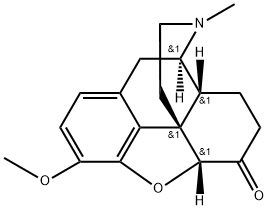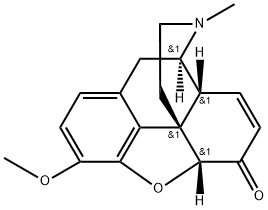Chemical Properties
Beige Solid
Originator
Dicodid,Knoll,Belgium
Uses
Analgesic (narcotic); antitussive.
Controlled substance (opiate).
Uses
Hydrocodone is a powerful anticough drug that is widely used for suppressing the cough
reflex. It is widely used in effective commercial anticough drugs in combination with
guaiphenesin (entuss), with homatropine (hycodan), with phenylpropanolamine (hycomine),
phenyltoloxamine (tussionex), and pseudoephedrine and guaiphenesin (tussened).
Definition
ChEBI: A morphinane-like compound that is a semi-synthetic opioid synthesized from codeine.
Manufacturing Process
60 g of codeine about 94.5% (anhydrous codeine alkaloid basis) was dissolved
in a solution made from 10 ml concentrated sulfuric acid and 390 ml water
The mixture was refluxed for one hour with 25.0 g of 5% Pd on charcoal. The
hot solution was immediately filtered and the catalyst was washed with 400
ml of dilute sulfuric acid of the same strength as was used in the
rearrangement described above. To the combined cooled filtrate and wash,
750 ml if benzene was added, after which the mixture was cooled to 15°C,
stirred, and made alkaline to pH 10 by addition of 80 ml of 40% NaOH. After
shaking and separating the aqueous layer was extracted twice with 500 ml
benzene. The combined benzene extracts are then extracted three times with
500 ml and twice with 400 ml portions of fresh 10% sodium bisulfite solution.
Crude dihydrocodeinone was precipitated from bisulfite solution by eddition of
180 ml 40% NaOH at 15°C (to pH 10). The product was filtered, washed well
and air-dried at room temperature. The melting point was about 184°C and
yield about 35-38 g or 58-59%. The product was darken and the rest of Pd on
charcoal and the original alkaloid were removed with column of Al2O3 (eluent
- dry ethylene chloride) to give the dihyrocodeinone.
Therapeutic Function
Narcotic analgesic, Antitussive
General Description
Hydrocodone is the 3 methoxy version of hydromorphone.The loss of the 3-OH group yields a compound that is approximately4 to 5 times less potent than hydromorphone, thusabout equal to morphine. Unlike codeine, the agonist activityof hydrocodone does not require 3-O-demethylation, althoughit does occur via CYP2D6 representing 4.6% of totalclearance. The protected 3-position has better brain penetration,and the 7,8-dihydro-6-keto C ring contributes to the increasedbinding of the compound to the μ-receptor.
There are no pure hydrocodone products available on theU.S. market. All FDA-approved products containing hydrocodoneare combination products. Like codeine, hydrocodoneis marketed as an antitussive agent. It is availablecombined with the anticholinergic agent homatropineas a syrup and a tablet. The addition of the anticholinergicagent is to discourage abuse. It is also available in a delayedrelease suspension form (Tussionex). This formulation usesa sulfonated styrene divinylbenzene copolymer complexedwith hydromorphone and chlorpheniramine that acts as acation-exchange resin slowly releasing the drugs over a 12-hour period. Hydrocodone is also marketed in combinationwith acetaminophen (Vicodin, Lortab) or aspirin (LortabASA) for the treatment of pain. The dose of acetaminophenconsumed by the patient must be closely monitored, andprescriptions that allow for greater than 4 grams of acetaminophenper 24-hour period should not be dispensed.
Safety Profile
Poison by intravenous and subcutaneous routes. When heated to decomposition it emits toxic fumes of NOx.




